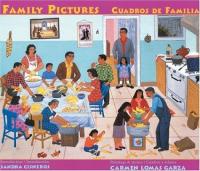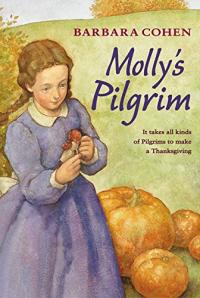
“My heart beats in two places.” So begins the tale of Jangmi, a young girl who is preparing to leave her home in Korea (382 Shin Dang Dong) for a new home in Massachusetts (112 Foster Terrace). Jangmi can’t bear the thought of leaving her house, her favorite willow trea, the monsoon rains, and most of all, her best friend Kisuni. Jangmi’s story and its hopeful conclusion will resonate with children who have left a beloved home or friend behind.
Good-Bye, 382 Shin Dang Dong

In a neighborhood of flower gardens, a Chinese-American girl and her mother plant what the child considers to be ugly vegetables. The ugly vegetables, however, become attractive and help build community when made into a delicious soup! A recipe is included.
The Ugly Vegetables

Mama and Papa are excited to take a break from working in the fields and go home, but Carlos and his sisters are not sure how they feel about traveling to Mexico. Soon after arriving, however, they meet their loving extended family, and the children begin to understand what it meant for their parents to leave home in order to offer the family a better future. David Diaz’s stunning illustrations layered on top of photos of Mexican folk art bring Eve Bunting’s beautiful story to life.
Going Home

Gita is ready for the Hindu celebration of Divali, but she is afraid that it just won’t be the same in her new home in Canada. When icy rain prevents the celebration they had planned, Gita becomes even more miserable, until she finds a way to light the darkness and remember Divali’s true meaning.
Lights for Gita

Say narrates the saga of his grandfather who as a young man travels to the United States in the early 20th century, marries, and returns to Japan. Watercolor portraits of people and places glimpse the contrast of cultures and parallel the lives of grandfather and grandson. It could lead to a discovery of family histories. Country of origin: Japan
Grandfather’s Journey

Starting school can be especially frightening if you don’t yet speak English. But Carmen is determined to learn English well in order to teach her little sister. With a supportive teacher and growing confidence, Carmen gradually learns the new language. Expressive illustrations complement this recognizable story.
Carmen Learns English

Based on the author’s experience, a child visits the village in Korea where her mother lived before immigrating to America. The simplicity of the text provides rich details of everyday life in the small Korean village, enhanced by realistic illustrations.
The Trip Back Home

“No one wants to eat Chinese food on the Fourth of July,” says a young girl to her parents who insist on keeping their Chinese restaurant open on Independence Day. An honest portrayal of the tug between traditions old and new, as well as what it really means to be American.
Apple Pie 4th of July

Yoon narrates the difficulty she experiences when her family moves to the United States from Korea. Her struggle with the transition focuses on the moment when she must learn to write her name in English rather than in Korean, and she remains resistant to learning a new language. Her imaginative voice is child-like and plausible, augmented by inventive illustrations.
My Name Is Yoon

Forced to leave the turmoil and political unrest of their native Vietnam, 13-year old Mai and her family cram into a boat and make way for Hong Kong and ultimately to America. Mai’s voice provides a necessary distance as she chronicles the journey and its horrors in with even tone.
Goodbye, Vietnam

Moon Shadow joins his father, traveling from China to San Francisco in the early 20th century. Together father and son confront harsh prejudice as well as kindness, and ultimately follow a dream to build a flying machine in this Newbery Honor novel.
Dragonwings

Through a quiet text and a series of stunning images created from embroidered cloth, the author relates her family’s often harrowing journey from China to Laos to Thailand, ultimately settling in the United States. An afterward provides additional history and ethnology.
Dia’s Story Cloth: The Hmong People’s Journey to Freedom

The artist recalls growing up in south Texas in this celebration of family and cultural traditions presented in vivid paintings and short prose in Spanish and English. Garza’s pride in her Mexican-American heritage is evident and celebrated in this handsome book.
Family Pictures

As a young boy, Cesar Chavez grew up on an 80-acre ranch in Arizona in the midst of joyous family reunions. When his family had to leave Arizona, however, to work as migrant laborers in California, their lives were turned upside down. During these excrutiating days and nights, Cesar struggled — but then found the resolve to one day help his fellow workers. Yuyi Morales brings Cesar’s childhood and early days as an organizer to life with stunning illustrations.
Harvesting Hope: The Story of Cesar Chavez

Nadia is thrilled to be the flower girl at her aunt’s wedding, yet continues to worries her classmates will respond on Monday to the temporary henna tattoos (mehndi). The intricate hand decorations that wear off slowly are a tradition of the family’s Pakistani background. Respect for tradition and the need to conform are at odds, but then resolved in this well-illustrated story.
Nadia’s Hands

Sparkling new illustrations refresh this Thanksgiving classic based on the true experience of a member of Barbara Cohen’s family. The touching story tells how recent immigrant Molly leads her third-grade class to discover that it takes all kinds of pilgrims to make a Thanksgiving.
Molly’s Pilgrim

When an American sailor meets a Japanese woman, they both try in secret to learn the other’s way of eating. Their courtship and growing love culminates in marriage. This realistic family story explores cultural similarities and differences and is told with humor and honesty by the couple’s daughter.
How My Parents Learned to Eat

A girl visits both sets of grandparents on weekends. On Saturdays, she speaks English with Grandpa and Grandma, while on Sundays, los domingos, she speaks Spanish with Abeulito and Abeulita. The format provides a glimpse at the subtle differences between cultures and highlights their similarities, one of which is each set of grandparents’ love for their granddaughter. Spanish words are interspersed in the fluid text.
I Love Saturdays y domingos

In writing about her childhood growing up in Camaguey, Cuba, Alma Flor Ada evokes all the senses. Readers will smell jasmine, coffee, and grandmother’s perfume. They will see the bats flying overhead and hear adults share stories. Companion volume to Where the Flame Trees Bloom.
Under the Royal Palms: A Childhood in Cuba

José lives in a diverse neighborhood where he’s just as likely to hear Spanish, English, or Chinese. The appealing photographs in this book document José’s life at home, at school, and on the streets of his colorful barrio in San Francisco, a city that is a dynamic mosaic of different cultures. Available in a Spanish.
Barrio: José’s Neighborhood / Barrio: El barrio de José

The irrepressible Gabi is tired of speaking two languages and feels like she’s messing up both. But what can she do if she is only allowed to speak Spanish at home? Gabi comes up with a solution that will make readers chuckle and recognize some of their own thinking in Gabi’s reasoning.
No More Spanish!

Instead of celebrating her 13th birthday in her prosperous Mexican home as she expected, Esperanza must adjust to the murder of her father, the loss of her house and wealth, and her new life as a farm worker in California. This readable coming-of-age novel is based on the life of the author’s grandmother.
Esperanza Rising

This tender novel describes a loving Japanese-American family from the point of view of the younger sister. Personal challenges and family tragedy, particularly the older sister’s struggle with lymphoma, are set against the oppressive social climate of the South during the 1950s and early 1960s. (2005 Newbery Medal Winner)
Kira-Kira

The new kid in school needs a new name! Or does she? Being the new kid in school is hard enough, but what about when nobody can pronounce your name? Having just moved from Korea, Unhei is anxious that American kids will like her.
